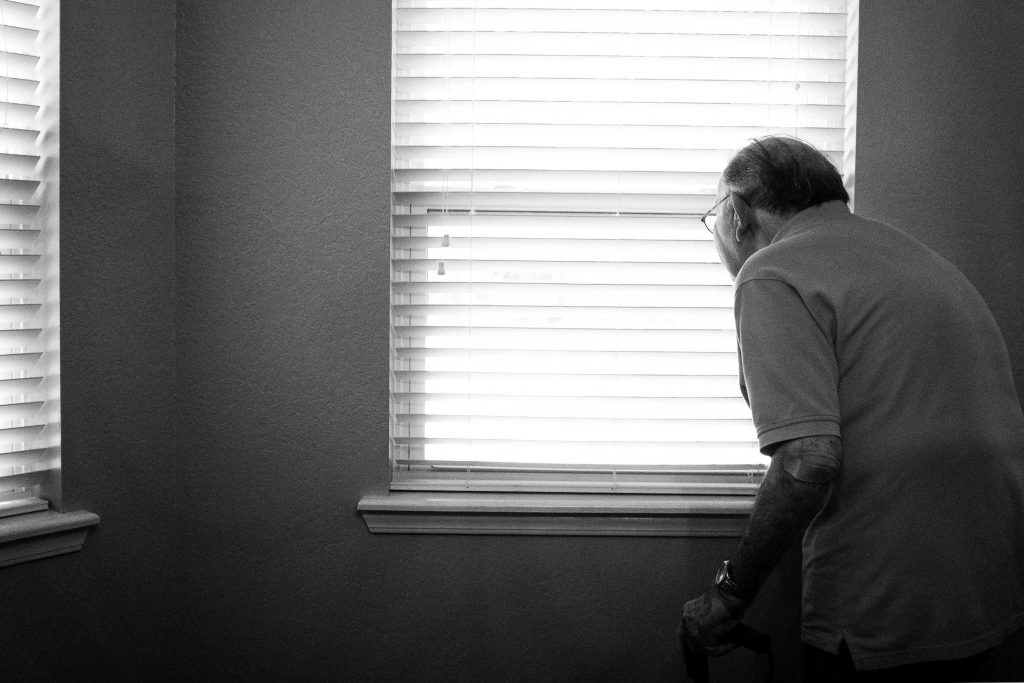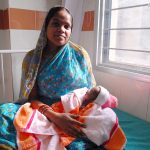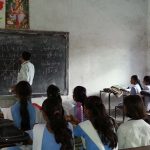An outcry
In a particularly disturbing scene in J.M. Coetzee’s novel, Waiting for the Barbarians, the protagonist defends four prisoners who are about to be killed with a sledgehammer. “Not with that!” he shouts, “. . . look at these men . . . Men!”
The outcry is a reminder of seeing human beings as human beings, seeing people as persons with dignity. The protagonist wants to say: Don’t you see that these are human beings? If you were to see that, you would not even think of torturing them! The heart of the matter is not an analysis, not a series of arguments—it is a question of perception. How can we learn to see clearly, to recognize and address structural injustice, racism, prejudice, systemic and systematic discrimination, and lift up the dignity of those who have been denied it?
The outcry “These are human beings!” has been heard the world over in past months. In Spain, when soldiers helping to fight the pandemic found “elderly patients in retirement homes abandoned and, in some cases, dead in their beds.” The same outcry could be heard in the United Kingdom where care homes felt “completely abandoned” as the pandemic swept across the country. The same outcry again in Italy, where commentators observed a “silent massacre” in nursing homes. In response to such cries of concern and solidarity, the Christian community of Sant’Egidio launched an international appeal in support of the elderly. Addressed to all—to individuals and institutions alike—it is a reminder of the dignity of each person as well as an expression of public resistance against selective health care. The appeal has been signed by, among others, Stefania Giannini, Jeffrey Sachs, Irina Bokova, Cardinal Matteo Zuppi, Annette Schavan and Jürgen Habermas.
In many ways, the pandemic has both revealed and deepened social inequities. In the United States, in reaction to the all-too-familiar fate of George Floyd, the outcry against brutal individual and systemic racism—This is a human being!—resonated around the world, where a chorus of voices cried “I can’t breathe.”
Yes, we are confronted with a terrifying reminder that misperception—blindness to systemic injustice—is more than just the indifference of the innocuous bystander. By failing to see, we deny dignity.
Many outcries, one single message: these are human beings!
A matter of perception
One of the deep insights into the concept of human dignity comes from Swiss philosopher Peter Bieri, in Human Dignity: A Way of Living (2017). Bieri claims that our understanding of human dignity enables and constitutes a particular form of life, a particular way of experiencing the world. The “work” the concept of human dignity is able to do affects our judgments and our perceptions. “Doing dignity” lays the foundation of a form of life.
For a concept to work, Ludwig Wittgenstein famously wrote, “there must be agreement not only in definitions but also (queer as this may sound) in judgments” (Philosophical Investigations, 242). We need to agree on ways of seeing the world, we need to agree in matters of perception.
The Dignity & Development blog can be seen as an invitation to see the world through a lens of human dignity and integral human development. Reflecting on our blog journey so far, we note that our colleagues at the Keough School of Global Affairs have offered essays that strive to see the world they once knew afresh, through the lens of what the COVID-19 crisis may have disclosed about our common human plight—and our shared human dignity. Wittgenstein’s concept of “seeing-as” holds that whenever we see something, we see it “as something.” Some of our authors thus far see a public health crisis; others, the collapse of the neoliberal illusion; still others, the consequences of ecologically irresponsible behavior.
This is a matter of perception. Our inaugural blog post clarified this project: “We aspire to see the debilitating impact of the coronavirus from the perspectives of the besieged women, children, and workers most affected by it; to raise awareness of the radical changes now required in sensibility, lifestyle and political economy.” The blog is meant to bring different perspectives together, but always with a central focus: the dignity of the human person. To date, each of the blog posts takes up a focused perspective on the pandemic and its consequences; taken together, however, the blogs address larger questions about the pandemic and human dignity. A set of key themes emerges.
The need for policies to attend to those who are most vulnerable
What emerges repeatedly across the blog posts is the crucial observation that the pandemic has acted not as a causal agent as much as a magnifier. Systemic weaknesses that existed prior to the pandemic have been magnified; and those who were already most severely punished by structural injustices are also those left with the fewest protections. While this may not be surprising, it has critical implications for social policy.
What is perhaps most “magnified” by the pandemic is the heartbreaking fact that many policies do not “see” the margins.
We were invited to look at particularly vulnerable persons, at undocumented (and unprotected) migrants, at Palestinians under Israeli occupation, at Mexican women under the weight of the lockdown, at refugees in a pandemic, at children and the increasing obstacles to their education. Through the lens afforded by the blogs we have “seen” the debilitating effects of the pandemic on the poor. The crisis threatens whatever gains people in poverty had made, pushes them further into poverty, heightens their fear, shatters their dreams.
Having conversations-in-dialogue about and with these groups may change our way of looking at the pandemic and sharpens our perception of forgotten aspects and invisible persons.
Perceptions are shaped by numerous social forces, both good and ill. Perceptions shape policies; policies shape perceptions. The systemic racial discrimination in the United States demonstrates this dynamic. Who cannot perceive now the depth of feeling, the cry of anguish, evoked by the recent reminders of the daily violations of the dignity of Black Americans? The emotions unleashed are powerful. Fear, for example, seems to authorize indifference and, in some cases, hatred. It creates a distorting lens by which some African Americans are seen, or not seen; so, too, the fear nurtured by the pandemic can “authorize” people to push aside the human dignity of the infected. The media has reported a similarly opaque way of seeing—and scapegoating—that has been encouraged by the pandemic, namely, racism against people from China and those appearing to be of East Asian descent. In such instances public discourse has deteriorated into seeing someone as something.
Another type of fear—our reluctance to accept the frightening fact that disasters will not simply “go away” after the current crisis passes—ensures, ironically, the fragility of systems intended to deal effectively with hidden disaster risks “amassing silently in the background of our daily lives—until they stare you in the face.”
Leadership and opportunity
Leadership matters. As we learned from the Ebola crisis, the moral and practical reasoning behind decisions and policies, communicated transparently, can shape not only public discourse, but also public perceptions and personal practices as well. The current pandemic has underscored the dire need for global leadership in the light of resurgent ultra-nationalisms and the authoritarian leaders who play to the jingoists and attempt to seduce the masses into seeing people as “us” or “them.” Troubled by this trend, our essayists hope for a new internationalism—it is a matter of perception to see oneself as “member of the human family,” rather than as merely a “national citizen.”
Leadership matters also with regard to racism and systemic discrimination. We have to teach “ways of seeing.” Can we, as the inaugural blog post stated, “imagine a world emerging from the pandemic, chastened but with new eyes to see, in which discussions about what has been revealed to us in the global crisis take center stage?”
Religions, which are in the business of forming people in and through faith, can play an important role in developing a global language and a global vision or way of seeing. One blog, written by Volodymyr Turchynovskyy, calls for reform in higher education, a kind of post-pandemic doubling down on the humanistic promise of universities and colleges, whose best teachers strive to inculcate in students “a sense of shared service and responsibility to humanity.”
Dignity as honor wound
Dignity can be perceived in many different ways. Some perceive it as coming only with the attainment of a certain honor, rank or special status in society. But the authors of this blog series see dignity not as an honor in the conventional sense, but as an inherent quality of each person, a quality that is to be honored in itself, apart from an external award or recognition. Ironically, dignity reveals itself even when, perhaps most powerfully when, it seems to have been egregiously violated.
Indeed, Kathleen Galvin and Les Todres have likened human dignity to an “honor wound,” the “felt aspect of valuing Being because of its vulnerability rather than in spite of its vulnerability…” This way of seeing the human person fosters a commitment to “upholding‐in‐vulnerability.”
It is not a matter of pretending that these vulnerabilities and wounds do not exist; we all carry them with us and cannot really hide them from others—or from ourselves. But we have to respond to our woundedness, and that of others, with a certain compassion, even tenderness, which is after all owed to human dignity and self-respect. Failure to heal all wounds is inevitable, but making no attempt at resolution, however imperfect, is unacceptable. It is “all right” to be vulnerable—but attention is required. It is “all right” to be wounded—but dignity demands “seeing” the wounds as opportunities to accompany and to be accompanied.
We would not have a discourse on human dignity, in other words, without the experience of vulnerability. The outcry, “These are human beings!” is an outcry in the face of vulnerability and woundedness. The pandemic has torn away a curtain and we have seen our nakedness, we have seen ugly inequality, we have seen the ruptures to international solidarity, we have seen the fragility of health and the delivery of health care. We have seen, in “the big reveal” of the crisis, new manifestations of racism and the fragility of the social contract in our country.
Pope Francis used the metaphor of a field hospital to characterize the mission of the Church in our world. This is a way of seeing the Church, but also a way of seeing the world. One could be tempted to say the same about the Keough School of Global Affairs—our school could be the place where we unite in the effort to prepare men and women to work in the field hospitals of this planet, our common home. This can happen through the fostering of a particular culture of perception that allows us to see people as persons, life as precious, vulnerability as costly, and dignity as an honor wound.
Clemens Sedmak is professor of social ethics at the Keough School of Global Affairs and interim director of the Nanovic Institute for European Studies.
Laura Miller-Graff is associate professor of psychology and peace studies at the Keough School of Global Affairs. She is a core faculty member of the Kroc Institute for International Peace Studies, part of the Keough School.
Scott Appleby is the Marilyn Keough Dean of Notre Dame’s Keough School of Global Affairs. A professor of history and scholar of global religion, he is the author or editor of 15 books and the recipient of four honorary doctorates. Appleby’s research examines the various ways in which religious movements and organizations shape, and are shaped by national, regional and global dynamics of governance, deadly conflict, international relations and economic development.
This article is part of a series of blog posts published by the Keough School of Global Affairs. Dignity and Development provides in-depth analysis of global challenges through the lens of integral human development.



